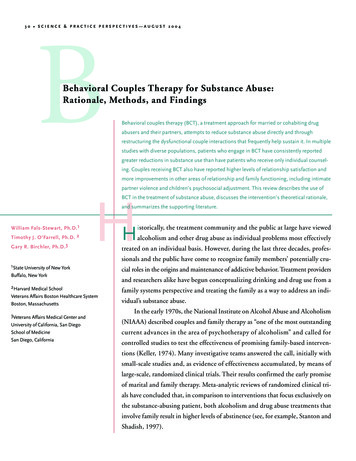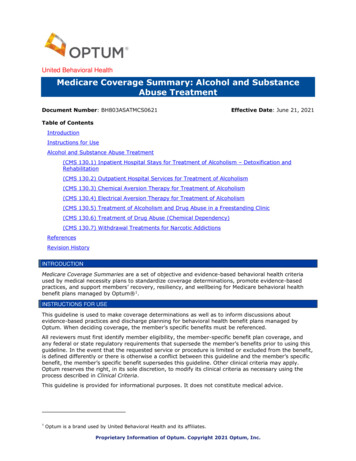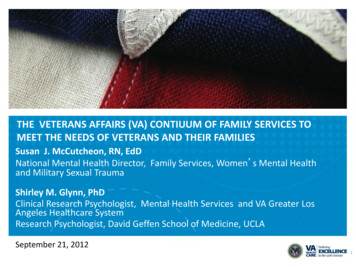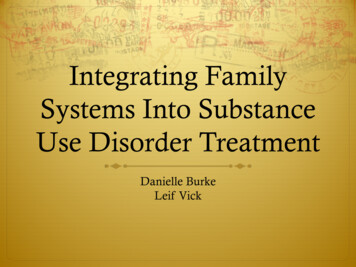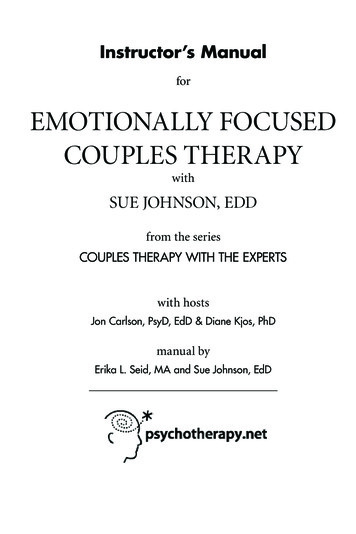
Transcription
You are Holding 2 CEs in Your Hand!The NASW MA Chapter is excited to continue this home study format for you to earn Category One CE Credits.We will do this four times a year in FOCUS. Enjoy the membership benefit of easy, inexpensive CEs.How it Works: Read all the articles on these four pages, complete the post-test and evaluation, and mail them to theChapter office with your check. Score 80% or better and NASW will mail you a certificate for 2 CEs. It’s That Easy!Behavioral Couples Therapy for Alcoholism and Drug AbuseBy Timothy J. O’Farrell, Ph.D. and Jane Alter, LICSW, Harvard Medical School and VA Boston Healthcare System Brockton, MALearning ObjectivesParticipants in this CE Program will:1. Understand clinical research findings supporting the use ofbehavioral couples therapy to treat alcoholism and drug abuse.2. Learn a step-by-step model of behavioral couples therapy thatpromotes abstinence and teaches relationship skills.3. Appreciate the importance of empirical research to supportpractice methods.4. Examine the concept of codependency in light of empiricalresearch.I. OVERVIEWThe purpose of Behavioral Couples Therapy (BCT) is to build support for abstinence and to improve relationship functioning amongmarried or cohabiting individuals seeking help for alcoholismor drug abuse. BCT sees the substance abusing patient with thespouse or live-in partner to arrange a daily “sobriety contract” inwhich the patient states his or her intent not to drink or use drugsand the spouse expresses support for the patient’s efforts to stayabstinent. For patients taking a recovery-related medication (e.g.,disulfiram, naltrexone), daily medication ingestion witnessed andverbally reinforced by the spouse also is part of the contract. Selfhelp meetings and drug urine screens are part of the contract formost patients. BCT also increases positive activities and teachescommunication skills.Behavioral Couples Therapy forAlcoholism and Drug Abuse Purpose of BCT is to increase relationshipfactors conducive to abstinence Daily Sobriety Contract supports abstinence Behavioral therapy increases positive feelings,shared activities, and constructive communication BCT fits well with self-help groups, recoverymedications and other counselingResearch shows that BCT produces greater abstinence and betterrelationship functioning than typical individual-based treatmentand reduces social costs, domestic violence, and emotional problems of the couple’s children. Despite the strong evidence basesupporting BCT, it is rarely used in substance abuse treatment programs. Low use of BCT may stem from the recency of studies onBCT, many of which were published in the past 10 years. Further,BCT clinical methods and the research supporting BCT have notbeen widely disseminated. This clinical guideline will acquaintsubstance abuse treatment program administrators and clinicianswith BCT. Hopefully this will lead to increased use of BCT to thebenefit of substance abusing patients and their families.II. BACKGROUND FOR BEHAVIORALCOUPLES THERAPYMeta-analytic reviews of randomized studies show more abstinencewith family-involved treatment than with individual treatment indrug abuse and in alcoholism. Overall the effect size favoring family-involved treatments over individual-based treatments was classified as a medium-size effect. This effect size is 10 times greaterthan that observed for aspirin in preventing heart attacks, an effect considered important in medical research. Behavioral couplestherapy (BCT) is the family therapy method with the strongest research support for its effectiveness in substance abuse.Primary Clinical Outcomes:Abstinence and Relationship FunctioningOver 15 studies have compared substance abuse and relationshipoutcomes for substance abusing patients treated with BCT or individual counseling. Outcomes have been measured at 6-monthsfollow-up in earlier studies and at 12-24 months after treatment inmore recent studies. The studies show a fairly consistent patternof more abstinence and fewer substance-related problems, happier relationships, and lower risk of couple separation and divorcefor substance abusing patients who receive BCT than for patientswho receive only more typical individual-based treatment. Theseresults come from studies with mostly male alcoholic and drugabusing patients, but 2 recent studies show similar results with female alcoholic and drug abusing patients.Studies of BCT Show BCT gives more abstinence, happier relationships, andfewer separations than individual (IND) Tx Benefit to cost ratio greater than 5:1 Domestic violence is greatly reduced Children helped more by BCT than IND BCT also works with family members other thanspouses BCT improves compliance with recoverymedications (e.g., disulfiram, naltrexone)Social Cost Outcomes and Benefit-to-Cost RatioThree studies (2 in alcoholism and 1 in drug abuse) have examinedsocial cost outcomes after BCT. These social costs included costsfor substance abuse-related health care, criminal justice system usefor substance-related crimes, and income from illegal sources andpublic assistance. The average social costs per case decreased substantially in the 1-2 years after as compared to the year before BCT,with cost savings averaging 5,000 - 6,500 per case. Reduced social costs after BCT saved more than 5 times the cost of deliveringBCT, producing a benefit-to-cost ratio greater than 5:1. Thus, forevery dollar spent in delivering BCT, 5 dollars in social costs aresaved. In addition, BCT was more cost-effective when compared
with individual treatment for drug abuse and when compared withinteractional couples therapy for alcoholism.Domestic Violence OutcomesA recent study examined male-to-female partner violence beforeand after BCT for 303 married or cohabiting male alcoholic patients. There also was a demographically matched comparisonsample of couples without alcohol problems. In the year beforeBCT, 60% of alcoholic patients had been violent toward their female partner, five times the comparison sample rate of 12%. In theyear after BCT, violence decreased significantly to 24% of the alcoholic sample but remained higher than the comparison group.Among remitted alcoholics after BCT, violence prevalence of 12%was identical to the comparison sample and less than half the rateamong relapsed patients (30%). Results for the second year afterBCT were similar to the first year. An earlier study found nearlyidentical results. Thus, these 2 studies showed that male-to-femaleviolence was significantly reduced in the first and second year afterBCT and that it was nearly eliminated with abstinence.Two recent studies showed that BCT reduced partner violence andcouple conflicts better than individual treatment. Among male drugabusing patients, while nearly half of the couples reported maleto-female violence in the year before treatment, the number reporting violence in the year after treatment was significantly lower forBCT (17%) than for individual treatment (42%). Among male alcoholic patients, those who participated in BCT reported less frequent use of maladaptive responses to conflict (e.g., yelling, namecalling, threatening to hit, hitting) during treatment than those whoreceived individual treatment. These results suggest that in BCTcouples do learn to handle their conflicts with less hostility and aggression.Impact of BCT on the Children of Couples Undergoing BCTKelley and Fals-Stewart conducted 2 studies (1 in alcoholism, 1 indrug abuse) to find out whether BCT for a substance abusing parent, with its demonstrated reductions in domestic violence and reduced risk for family breakup, also has beneficial effects for thechildren in the family. Results were the same for children of malealcoholic and male drug abusing fathers. BCT improved children’sfunctioning in the year after the parents’ treatment more than didindividual-based treatment or couple psychoeducation. Only BCTshowed reduction in the number of children with clinically significant impairment.Integrating BCT with Recovery Related MedicationBCT has been used to increase compliance with a recovery-relatedmedication. Fals-Stewart and O’Farrell compared BCT with individual treatment for male opioid patients taking naltrexone. BCTpatients, compared with their individually treated counterparts,had better naltrexone compliance, greater abstinence, and fewersubstance-related problems. Fals-Stewart, O’Farrell and Martinfound that BCT produced better compliance with HIV medications among HIV-positive drug abusers in an outpatient drug abusetreatment program that did treatment as usual. BCT also has improved compliance with pharmacotherapy in studies of disulfiramfor alcoholic patients and in an ongoing pilot study of naltrexonewith alcoholics.BCT with Family Members Other than SpousesMost BCT studies have examined traditional couples. However,some recent studies have expanded BCT to include family members other than spouses. These studies have targeted increased medication compliance as just described. For example, in the study ofBCT and naltrexone with opioid patients, family members takingpart were spouses (49%), parents (36%), and siblings (15%). In thestudy of BCT and HIV medications among HIV-positive drug abusers, significant others who took part were: a parent or sibling (67%),a same-sex(12%) or opSuitable Cases for BCTpostie-sex Married or cohabiting couples(9%) part Reside together or reconcilener, or a Not psychotic past 90 days Not high risk of injurious/lethal violenceroommate Start after detox, rehab, or no prior Tx(12%).Needed ResearchIn terms of future directions, we do need more research on BCT, toreplicate and extent the most recent advances, especially for women patients and broader family constellations. Research on BCTfor couples in which both the male and female member have acurrent substance use problem is particularly needed because prior BCT studies have not addressed this difficult clinical challenge.Even more than additional research, we need technology transferso that patients and their families can benefit from what we havealready learned about BCT for alcoholism and drug abuse.III. CLINICAL GUIDELINE FOR BEHAVIORALCOUPLES THERAPYBCT works directly to increase relationship factors conducive toabstinence. A behavioral approach assumes that family memberscan reward abstinence -- and that alcoholic and drug abusing patients from happier, more cohesive relationships with better communication have a lower risk of relapse. The substance abusing patient and the spouse are seen together in BCT, typically for 12-20weekly outpatient couple sessions over a 3-6 month period. BCTcan be an adjunct to individual counseling or it can be the onlysubstance abuse counseling the patient receives. Generally couplesare married or cohabiting for at least a year, without current psychosis, and one member of the couple has a current problem withalcoholism and/or drug abuse. The couple starts BCT soon afterthe substance abuser seeks help. BCT can start immediately afterdetoxification or a short-term intensive rehab program or when thesubstance abuser seeks outpatient counseling. The remainder ofthis guideline is written in the form of instructions to a counselorwho wants to use BCT.To engage the spouse and the patient together in BCT, first getthe substance abusing patient’s permission to contact the spouse.Then talk directly to the spouse to invite him or her for an initialBCT couple session. The initial BCT session involves assessingsubstance abuse and relationship functioning and gaining commitment to starting BCT. You start first with substance-focused interventions that continue throughout BCT to promote abstinence.When abstinence and attendance at BCT sessions have stabilizedfor a month or so, you add relationship-focused interventions to in-
creases positive activities and teach communication. These specific BCT interventions are described in detail next.Substance-Focused Interventions in BCT: Daily Sobriety ContractYou can arrange what we call a daily Sobriety Contract or RecoveryContract. The first part of the contract is the “sobriety trust discussion.” In it, the patient states his or her intent not to drink or usedrugs that day (in the tradition of one day at a time) and the spouseexpresses support for the patient’s efforts to stay abstinent. For patients taking a recovery-related medication (e.g., disulfiram, naltrexone), daily medication ingestion witnessed and verbally reinforced by the spouse also is part of the contract. The spouserecords the performance of the daily contract on a calendar yougive him or her. Both partners agree not to discuss past drinkingor fears about future drinking at home to prevent substance-related conflicts which can trigger relapse, reserving these discussionsfor the therapy sessions. At the start of each BCT session, reviewthe Sobriety Contract calendar to see how well each spouse hasdone their part. Have the couple practice their trust discussion (andmedication taking if applicable) in each session to highlight its importance and to let you see how they do it. Twelve-step or otherself-help meetings are a routine part of BCT for all patients whoare willing. Urine drug screens taken at each BCT session are included in BCT for all patients with a current drug problem. If theSobriety Contract includes 12-step meetings or urine drug screens,these are also marked on the calendar and reviewed. The calendarprovides an ongoing record of progress that you reward verballyat each session.Sobriety Contract Daily Sobriety Trust Discussion Alcohol/drug abuser states intention to stay abstinentthat day Spouse thanks alcohol/drug abuser for efforts to stayabstinent Medication to aid recoverySelf-help involvementWeekly drug urine screensCalendar to record progressSobriety Contract Case Example #1. Mary was a 34-year oldteacher’s aide in an elementary school who had a serious drinking problem and also smoked marijuana daily. She was admittedto a detoxification unit at a community hospital after being caughtdrinking at work and being suspended from her job. Her husbandJack worked in a local warehouse and was a light drinker with nodrug involvement. Mary and Jack had been married 8 years, andJack was considering leaving the marriage, when the staff at thedetoxification unit referred them to the behavioral couples therapy program.The therapist developed a contract in which Mary agreed to a daily “trust discussion” in which she stated to Jack her intent to stay“clean and sober” for the next 24 hours and Jack thanked her forher commitment to sobriety. The couple practiced this ritual in thetherapist’s office until it felt comfortable, and then also performedthe discussion at each weekly therapy session on Wednesday evening. They did this part of the contract nearly every day, missingonly on an occasional Saturday because their schedule was differ-ent that day and sometimes they forgot. Mary agreed to at leasttwo AA meetings each week and actually attended 3 meetings perweek for the first two months. Jack was pleased to see Mary goingto AA and not drinking. However, he was upset that weekly drugurine screens were positive for marijuana for the first few weeks,taking this as evidence that his wife was still smoking marijuanaeven though she denied it. The therapist explained that marijuana could stay in the system for some time particularly in someonewho had been a daily pot smoker. The therapist suggested Jack goto Al-Anon to help him deal with his distress over his wife’s suspected drug use. After a few weeks, the drug screens were negative for marijuana and stayed that way lending further credenceto Mary’s daily statement of intent. Jack found Al-Anon helpfuland the couple added to their contract that one night a week theywould go together to a local church where Mary could attend anAA meeting and Jack could go to an Al-Anon meeting.Sobriety Contract with a Recovery MedicationA medication to aid recovery is often part of BCT. Medicationsinclude Naltrexone for heroin-addicted or alcoholic patients andAntabuse (disulfiram) for alcoholic patients. Antabuse is a drugthat produces extreme nausea and sickness when the person taking it drinks. As such it is an option for drinkers with a goal of abstinence. Traditional Antabuse therapy often is not effective because the drinker stops taking it. The Antabuse Contract, also partof the Community Reinforcement Approach, significantly improves compliance in taking the medication and increases abstinence rates. In the Antabuse Contract, the drinker agrees to takeAntabuse each day while the spouse observes. The spouse, in turn,agrees to positively reinforce the drinker for taking the Antabuse,to record the observation on a calendar you provide them, and notto mention past drinking or any fears about future drinking. Eachspouse should view the agreement as a cooperative method for rebuilding lost trust and not as a coercive checking-up operation.Before negotiating such a contract, make sure that the drinker iswilling and medically cleared to take Antabuse and that both thedrinker and spouse have been fully informed and educated aboutthe effects of the drug. This is done by the prescribing physicianbut double check their level of understanding about it.Sobriety Contract Case Example #2. The next case is Bill Jones,a 42-year old truck driver with a chronic alcoholism problem, andhis wife Nancy who drank only occasionally. The staff at the detoxification unit also referred this couple to our program. DailyAntabuse observed and reinforced by the wife was part of theircontract in addition to the daily trust discussion in which Bill stated his intent to stay sober. Drug urine screens were not part ofthe contract because Bill did not have a problem with any substance other than alcohol. The therapist thought each member ofthe couple was a good candidate to benefit from 12-step meetings,but Bill refused AA and Nancy was reluctant to attend Al-Anon.Thus, 12-step meetings were not part of their contract. During thefirst 2 weeks of trying out the contract, the couple were inconsistent in performing the contract due to logistical problems and totheir continued anger and distrust with each other -- a commonproblem. The therapist worked with the couple to overcome theseproblems and the couple eventually did the contract consistentlyeach day and felt it helped them. After 6 months Bill stopped taking Antabuse, but the daily trust discussion was continued for an
additional 6 months and this proved a satisfactory arrangement forboth Bill and Nancy.Other Support for AbstinenceReviewing urges to drink or use drugs experienced in the past weekis part of each BCT session. This includes thoughts and temptations that are less intense than an urge or a craving. Discussing situations, thoughts and feeling associated with urges helps identifypotential triggers or cues for alcohol or drug use. It can help alertyou to the possible risk of a relapse. It also identifies successfulcoping strategies (e.g., distraction, calling a sponsor) the patientused to resist an urge and builds confidence for the future.Crisis interventionfor Reviewing urges to drink or use drugssubstance use Helps identify substance use triggersis an important Resisting urges builds confidencepart of BCT. Crisis intervention for substance use Get substance use stopped quicklyDrinkingor Use as a learning experiencedrug use episodesoccurduring BCT as with any other treatment. BCT works best if youintervene before the substance use goes on for too long a period.In an early BCT session, negotiate an agreement that either member of the couple should call you if substance use occurs or if theyfear it is imminent. Once substance use has occurred, try to getit stopped and to see the couple as soon as possible to use the relapse as a learning experience. At the couple session, you must beextremely active in defusing hostile or depressive reactions to thesubstance use. Stress that drinking or drug use does not constitutetotal failure, that inconsistent progress is the rule rather than the exception. Help the couple decide what they need to do to feel surethat the substance use is over and will not continue in the coming week (e.g., restarting recovery medication, going to AA andAl-Anon together, reinstituting a daily Sobriety Contract, enteringa detoxfication unit). Finally, try to help the couple identify whattrigger led up to the relapse and generate alternative solutions other than substance use for similar future situations.Other Support for AbstinenceRelationship-Focused Interventions in BCTOnce the Sobriety Contract is going smoothly, the substance abuser has been abstinent and the couple has been keeping scheduledappointments for a month or so, you can start to focus on improving couple and family relationships. Family members often experience resentment about past substance abuse and fear and distrustabout the possible return of substance abuse in the future. The substance abuser often experiences guilt and a desire for recognitionof current improved behavior. These feelings experienced by thesubstance abuser and the family often lead to an atmosphere of tension and unhappiness in couple and family relationships. There areproblems caused by substance use (e.g. bills, legal charges, embarrassing incidents) that still need to be resolved. There is often abacklog of other unresolved couple and family problems that thesubstance use obscured. The couple frequently lacks the mutualpositive feelings and communication skills needed to resolve theseproblems. As a result, many marriages and families are dissolvedduring the first 1 or 2 years of the substance abuser’s recovery. Inother cases, couple and family conflicts trigger relapse and a returnto substance abuse. Even in cases where the substance abuser hasa basically sound marriage and family life when he or she is notabusing substances, the initiation of abstinence can produce temporary tension and role readjustment and provide the opportunityfor stabilizing and enriching couple and family relationships. Forthese reasons, many alcohol abusers can benefit from assistance toimprove their couple and family relationships.Two major goals of interventions focused on the drinker’s couple/family relationship are (a) to increase positive feeling, goodwill,and commitment to the relationship; and (b) to teach communication skills to resolve conflicts, problems, and desires for change.The general sequence in teaching couples and families skills to increase positive activities and improve communication is (a) therapist instruction and modeling, (b) the couple practicing underyour supervision, (c) assignment for homework, and (d) review ofhomework with further practice.Increasing Positive ActivitiesCatch Your Partner Doing Something Nice. A series of procedurescan increase a couple’s awareness of benefits from the relationship and the frequency with which spouses notice, acknowledge,and initiate pleasing or caring behaviors on a daily basis. Tell thecouple that caring behaviors are “behaviors showing that you carefor the other person,” and assign homework called “Catch YourPartner Doing Something Nice” to assist couples in noticing daily caring behaviors. This requires each spouse to record one caring behavior performed by the partner each day on sheets you provide them. The couple reads the caring behaviors recorded duringthe previous week at the subsequent session. Then you model acknowledging caring behaviors (“I liked it when you .It made me feel .”), noting the importance of eyecontact; a smile; a sincere, pleasant tone of voice; and only positivefeelings. Each spouse then practices acknowledging caring behaviors from his or her daily list for the previous week.After theIncreasing Positive Activitiescouple Catch Your Partner Doing Something Nicepractices Caring Day Assignment Shared Rewarding Activtiesthe newbehaviorin the therapy session, assign for homework a 2-5 minute dailycommunication session at home in which each partner acknowledges one pleasing behavior noticed that day. These daily brief acknowledgments often are done at the same time as the “trust discussion” that is part of the Sobriety Contract. As couples begin tonotice and acknowledge daily caring behaviors, each partner be-Catch Your Partner Doing Something NiceName: MikePartner’s Name: 04/114/12PLEASING BEHAVIOR NOTICEDWaited to have dinner with me when I had tostay late at workTold me she loved meCooked a delicious dinnerWas patient with me when I came hometired and moody from workEnjoyed a walk togetherWoke me gently and rubbed my backHelped plan a picnic with friends
gins initiating more caring behaviors. Often the weekly reports ofdaily caring behaviors show that one or both spouses are fulfillingrequests for desired change voiced before the therapy. In addition,many couples report that the 2-5 minute communication sessionsresult in more extensive conversations.Caring Day. A final assignment is that each partner give the other a“Caring Day” during the coming week by performing special actsto show caring for the spouse. Encourage each partner to take risksand to act lovingly toward the spouse rather than wait for the other to make the first move. Finally, remind spouses that at the startof therapy they agreed to act differently (e.g., more lovingly) andthen assess changes in feelings, rather than wait to feel more positively toward their partner before instituting changes in their ownbehavior.Planning Shared Rewarding Activities. Many substance abusers’ families stop shared recreational and leisure activities dueto strained relationships and embarrassing substance-related incidents. Reversing this trend is important because participationby the couple and family in social and recreational activities improves substance abuse treatment outcomes. Planning and engaging in shared rewarding activities can be started by simply havingeach spouse make a separate list of possible activities. Each activity must involve both spouses, either by themselves or with theirchildren or other adults and can be at or away from home. Beforegiving the couple homework of planning a shared activity, modelplanning an activity to illustrate solutions to common pitfalls (e.g.,waiting until the last minute so that necessary preparations cannot be made, getting sidetracked on trivial practical arrangements).Finally, instruct the couple to refrain from disTeaching Communicationcussing problems or Listening Skillsconflicts during their Expressing Feelings Directlyplanned activity. Communication Sessions Negotiating for RequestsTeachingCommunication SkillsWe generally begin our work on training in communication skillsby defining effective communication as “message intended (byspeaker) equals message received (by listener)” and emphasizingthe need to learn both “listening” and “speaking” skills. The chartpresented below helps expand this definition further including factors (e.g., “filters”) in each person that can impede communication.Teaching couples communication skills of listening and speakingand how to use planned communication sessions are essential prerequisites for negotiating desired behavior changes. Start this training with non-problem areas that are positive or neutral and move toproblem areas and emotionally charged issues only after each skillhas been practiced on easier topics.Listening Skills. Good listening helps each spouse to feel understood and supported and to slow down couple interactions to prevent quick escalation of aversive exchanges. Instruct spouses to repeat both the words and the feelings of the speaker’s message andto check to see if the message they received was the message intended by their partner (“What I heard you say was. Is that right?”) When the listener has understood the speaker’smessage, roles change and the first listener then speaks. Teaching apartner to communicate support and understanding by summarizing the spouse’s message and checking the accuracy of the receivedmessage before stating his or her own position is often a major accomplishment that has to be achieved gradually. A partner’s failure to separate understanding the spouse’s position from agreementwith it often is an obstacle that must be overcome.Expressing Feelings Directly. Expressing both positive and negative feelings directly is an alternative to the blaming, hostile, andindirect responsibility-avoiding communication behaviors thatcharacterize many substance abusers’ relationships. Emphasizethat when the speaker expresses feelings directly, there is a greaterchance that he or she will be heard because the speaker says theseare his or her feelings, his or her point of view, and not some objective fact about the other person. The speaker takes responsibilityfor his or her own feelings and does not blame the other person forhow he or she feels. This reduces listener defensiveness and makesit easier for the listener to receive the intended message. Presentexamples of differences between direct expressions of feelings andindirect and ineffective or hurtful expressions. The use of statements beginning with “I” rather than “you” is emphasized. Afterpresenting the rationale and instructions, model correct and incorrect ways of expressing feelings and elicit the couple’s reactions tothese modeled scenes. Then have the couple role-play a communication session in which spouses take turns being speaker and listener, with the speaker expressing feelings directly and the listener using the listening response. During this role-playing, coach thecouple as they practice reflecting the direct expressions of feelings.Assign for homework similar communication sessions, 10-15 minutes each, three to four times weekly. Subsequent therapy sessionsinvolve more practic
behavioral couples therapy to treat alcoholism and drug abuse. 2. Learn a step-by-step model of behavioral couples therapy that promotes abstinence and teaches relationship skills. 3. Appreciate the importance of empirical research to support practice methods. 4. Examine the concept of codependency in light of empirical research.

